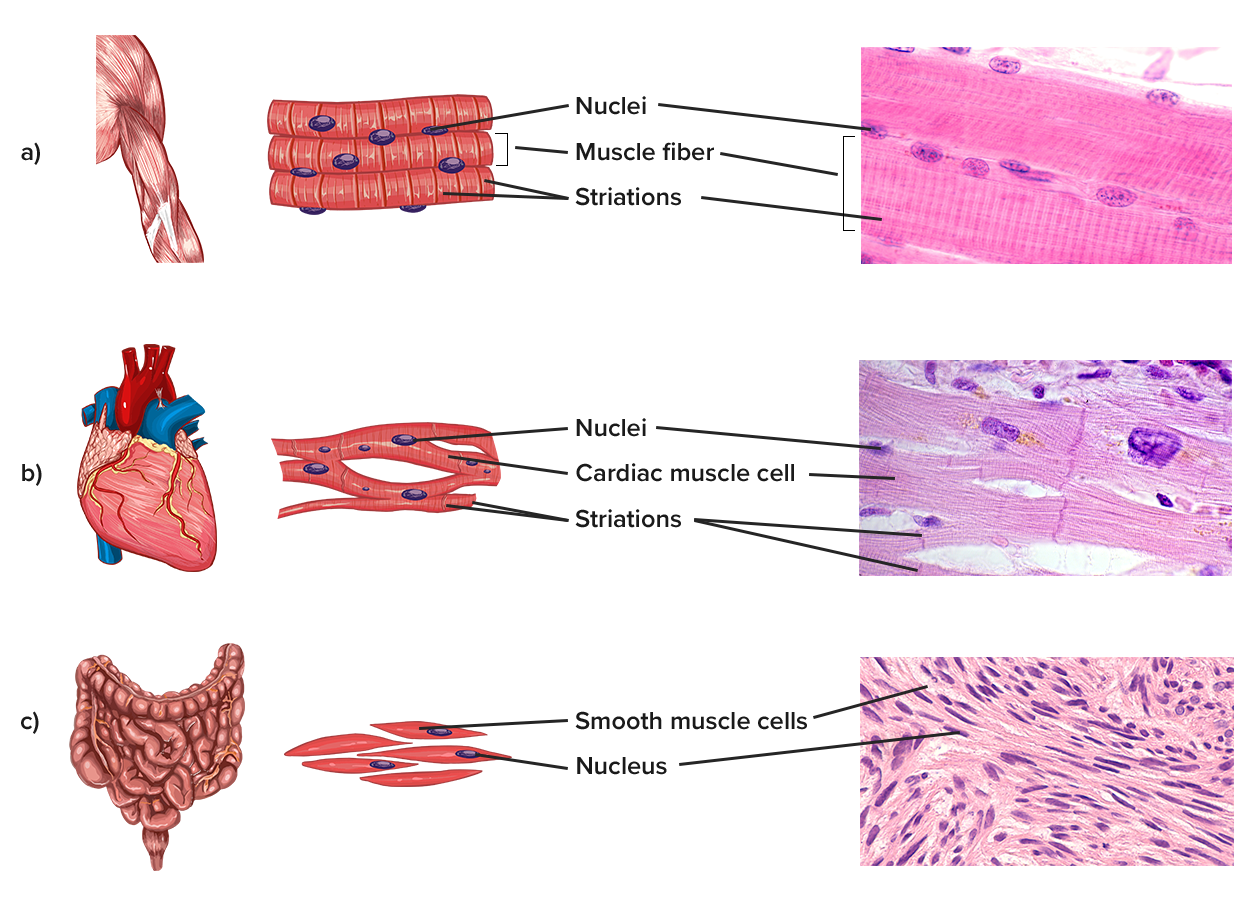Table of Contents |
Muscle tissue functions to allow for movement. In order to provide this function, all muscle cells share several characteristics:
EXAMPLE
Some muscle movement is voluntary, which means it is under conscious control. A person decides to open a book and read a chapter on anatomy. Other movements are involuntary, meaning they are not under conscious control, such as the contraction of the pupil in your eye in bright light. Muscle tissue is classified into three types according to structure and function: skeletal, cardiac, and smooth.| Tissue | Histology | Function | Location |
|---|---|---|---|
| Skeletal | Long cylindrical fiber, striated, many peripherally located nuclei | Voluntary movement, produces heat, protects organs | Attached to bones and around entrance points to the body (e.g., mouth, anus) |
| Cardiac | Short, branched, striated, single central nucleus | Involuntary movement, contracts to pump blood | Heart |
| Smooth | Short, spindle-shaped, no evident striation (smooth appearance), a single nucleus in each fiber | Involuntary movement, moves food, involuntary control of respiration, moves secretions, regulates the flow of blood in arteries by contraction | Walls of major organs and passageways |
Skeletal muscle is a voluntary muscle tissue that is attached to bones (i.e., the skeleton) as well as skin. Contraction of skeletal muscle makes locomotion, facial expressions, and posture possible. As a byproduct of their contraction, skeletal muscles generate heat thus contributing to the body's thermal homeostasis. When the body temperature drops, muscles respond involuntarily by shivering—tiny contractions which help increase body temperature.
Cardiac muscle is an involuntary muscle tissue that forms the contractile walls of the heart. The cells of cardiac muscle, known as cardiomyocytes, also appear striated under the microscope. Unlike skeletal muscle fibers, cardiomyocytes are single cells typically with a single centrally located nucleus. A principal characteristic of cardiomyocytes is that they contract on their own intrinsic rhythms without any external stimulation. Cardiomyocytes attach to one another with specialized cell junctions called intercalated discs. Intercalated discs have both anchoring junctions and gap junctions. Attached cells form long, branching cardiac muscle fibers that are, essentially, a mechanical and electrochemical syncytium allowing the cells to synchronize their actions. The cardiac muscle pumps blood through the body and is under involuntary control. The attachment junctions hold adjacent cells together across the dynamic pressure changes of the cardiac cycle.
Smooth muscle tissue contraction is responsible for involuntary movements in the internal organs. It forms the contractile component of the digestive, urinary, and reproductive systems as well as the airways and arteries. Each cell is spindle-shaped with a single nucleus and no visible striations which creates its smooth cellular appearance.

Source: THIS TUTORIAL HAS BEEN ADAPTED FROM OPENSTAX “ANATOMY AND PHYSIOLOGY 2E.” ACCESS FOR FREE AT HTTPS://OPENSTAX.ORG/DETAILS/BOOKS/ANATOMY-AND-PHYSIOLOGY-2E. LICENSE: CC ATTRIBUTION 4.0 INTERNATIONAL.